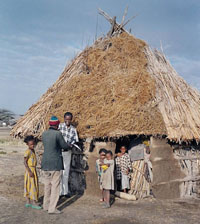Collecting data for the community profile
Alemitu knew that the first thing she needed to do when she started her job was to collect baseline data in order to produce a community profile. So she began planning a community survey to collect data to build up the information for her community profile. She started documenting relevant facts from her previous knowledge as a member of the community, but the area was too large for her to survey every household in a short time. First, she sought the support of the community leaders, liaising with them and asking about their knowledge of the community and its people. This helped her to recruit community volunteers. She briefed the volunteers on how to conduct the community survey, using a specially prepared questionnaire. After training in their roles and responsibilities, Alemitu coordinated the community volunteers going from house to house asking the questions in the community survey and collecting the answers.

Some of the results of the community survey related to the geographical and social features of Alemitu's community. She was able to establish that:
- The population of her community is 5,456 individuals, with (on average) five people per household.
- Almost all of the families within the community earn a living from farming.
- Many areas of the community are hard to reach because of the mountainous landscape.
- There is only one available dry weather road from the district health office leading to her community.
- Some parts of the community are drought-prone, so there are seasonal nutritional problems among the children.
- It takes an average of eight hours for members of her community to get to the nearest health facility.
- No local or international NGOs are operating in the community.
- There is limited electricity and no mobile phone access in the community.
- There is a traditional health delivery system offered by certain members of the community (for example, spiritual healers and suppliers of herbal medicines).
In addition to the points listed above, Alemitu needed other survey information to complete her community profile. She needed to collect demographic data on the ages, genders and circumstances of the people in every household in the community, whether the children and mothers have been immunized, how many women are pregnant, etc. She also needed epidemiological data about the public health issues that affect the community, e.g. 'Is malaria endemic in the area?', 'Have children died from diarrhoeal diseases or pneumonia?', 'What was the maternal mortality rate during the previous years?', etc.
